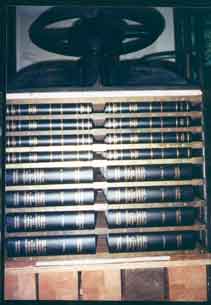Meet the Bookbinder
David Myhre
I started my hand bookbinding apprenticeship in 1967 at a trade bindery in Seattle. This four year program consisted of all aspects of casebinding and some fine binding, including much training in hot-foil stamping and embossing. Then I served another four year apprenticeship in the mechanical aspects of the bindery ( folding machines, paper cutters, stitchers etc.). After that, I started my own business, and built a book bindery at my home where I create high quality hand made books and binders.
I have been collecting and restoring antique hand bookbinding machines and equipment for many years. Many of my clients say that I work in a museum.
 |
|||
 |
|||
 |
|||
The frame sewing of folded signatures is time consuming, but creates a finished book that lies opened flat.
 |
 |
||
After the book is sewn and the spine is glued, the edges can be trimmed.
 |
 |
||
 |
|||
 |
|||
Then the spine of the book is formed in a process called "rounding and backing". After the book block is finished with the application of headbands and backing flannel (not pictured), the materials are cut in preparation for the making of the book cover.
 |
 |
|
Then, a coating of glue is applied to the cover material the cover boards are applied
 |
 |
||
 |
|||
The corners are mitered (above), the cloth edges are folded over the binders board and the new finished cover is put under weights to dry. (below)
 |
 |
 |
|
Then the process of "finishing" (hot foil stamping) can begin. The book cover can be stamped in almost any color.


Large foil stamping runs are done on the pneumatic stamping machine.


The last part of the binding process involves putting the finished cased in books into the press between brass edged boards to form the hinge